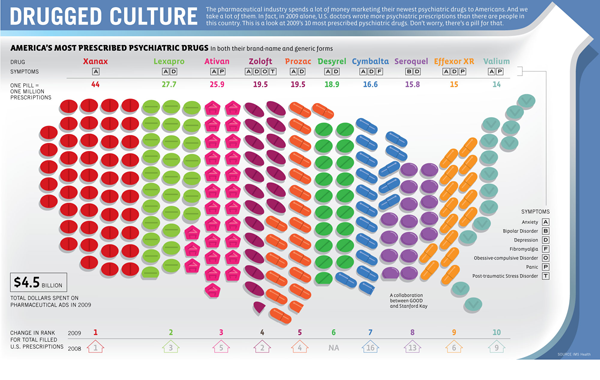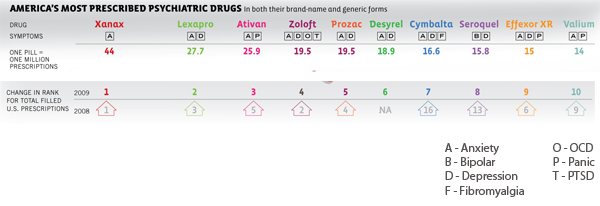
What works
Um, so, I’m trying to think of what is working here. I guess we see that there are about 10 psychiatric drugs, that lots of people appear to be receiving treatment for anxiety (heck, two wars, an economic crisis, trapped Chilean miners, BP’s oil spill…all this anxiety makes sense to me). We are meant to believe that this represents a huge and possibly stifling example of big pharma. But really, this graphic doesn’t say that to me. It says “lots of people are anxious and choosing to take prescription drugs to cope”.

What needs work
Just for some crazy antic fun, infographic style, I whipped out my digital crop tool and got rid of the map just to see what we would lose. Clearly, we lose some fun. Almost all the pretty colors are gone. But the information? It’s all still there. The map was being used as a giant and rather useless crutch in this case. This is a particularly egregious case, but there are many instances of maps that don’t encode any information that is useful for the debate of the topic at hand. Ask yourself: what did the map do? Was there any variation contained in the map? Was the dataset in question geographically oriented in any way? No. No, it was not.
Thanks to Austin Haney, Sociology grad student at Kent State for sending this our way.
References
Drugged Culture GOOD magazine, Transparency Blog.
(2010) One Nation Under Xanax in Psychiatric Times.

Comments 3
Elyas — October 20, 2010
The tidbit at the top about doctors writing more psychiatric prescriptions than there are people in the country says that, but I agree, it doesn't really come across in the graphic.
Laura Norén — October 20, 2010
Well, and the bigger point that I wonder about it whether or not taking a pill is necessarily a bad thing. There are good reasons that lots of people might have been anxious in 2008-2009 so if taking a pill helps them feel better, should we be up in arms that big pharma is a big problem? In the Psychiatric Times article that dealt with the same set of numbers, a practicing psychologist, Dr. Jeffrey A. Lieberman, said that his concern there are “so many good generic psychiatric drugs” that big pharmaceutical companies may not be motivated to produce new ones. Is this a problem? I'm no expert but the same doctor said that there is a “huge, unmet need" for drugs to treat depression, schizophrenia, and bipolar disorder.
I should have posted more of what Dr. Lieberman had to say in the original post. Thanks for pointing out the question.
Also note: when counting prescriptions as compared to people, since many psychiatric conditions are considered temporary and since the drugs are considered habit forming, any individual scrip will have fewer refills than, say, a scrip for something like hypothyroidism. Therefore, the same ongoing mental illness may require more prescriptions written than other kinds of illnesses. One prescription for birth control will last a woman a year, usually, but if she needed to be on Xanax for a year she would probably require a number of prescriptions for the same thing, though I don't know how many. Further, it also seems like getting the right scrip to treat a particular person's mental illness takes some tinkering, so there could be a goldlilocks scenario going on that pumps up the number of scrips written. "These side effects are too much, this treatment is too little, but this pill is just right."
Elyas — October 20, 2010
I wasn't arguing that taking a pill is necessarily a bad thing and don't think it's a question of whether it is categorically good or bad. While there are plenty of reasons for anxiety in 2008-2009, psychiatric prescriptions grew 73% among adults and 50% among children between 1996 and 2006. Was there really that much unmet need? While patient need probably accounts for some of that growth, so does affordability/access, physician practice habits (use of therapy has declined as prescriptions have increased), and pharmaceutical company marketing efforts, to some extent. I think it's fair to acknowledge both that for many people these prescriptions are very beneficial and that something else may be going on with the rapid growth (treating mental disorders is now the #1 most costly condition for children under 17).